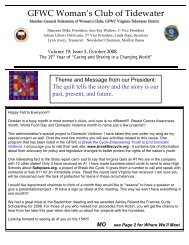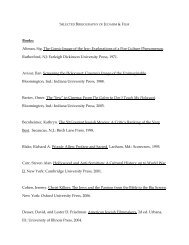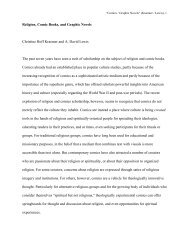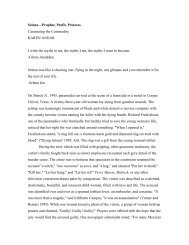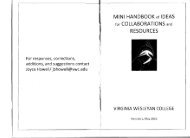Cohn, Jacob. The Royal Table - VWC: Faculty/Staff Web
Cohn, Jacob. The Royal Table - VWC: Faculty/Staff Web
Cohn, Jacob. The Royal Table - VWC: Faculty/Staff Web
Create successful ePaper yourself
Turn your PDF publications into a flip-book with our unique Google optimized e-Paper software.
BASES OF THE DIETARY LAWS 45<br />
cated; similarly, by associating the immoral with the ugly,<br />
men acquire the conditioned response of restraint from it.<br />
"You shall not cut around the corners of your head or<br />
destroy the corners of your beard. You shall not gash<br />
your flesh, or tattoo yourselves. I am the Lord" (Lev.<br />
XIX). By associating in a general taboo eating-with-theblood<br />
with such practices as disfigure the body or mar its<br />
beauty, the Torah established a feeling of repulsion towards<br />
the first act similar to the normal aesthetic reaction of<br />
displeasure<br />
with the second. An animal which died of<br />
itself is repugnant; and sensitive people will refrain from<br />
eating it. By including animals not ritually slaughtered<br />
but killed in cruel immoral fashion in the same class with<br />
carrion, the same aversion is established toward the latter<br />
which normally exists towards the former, and thus the<br />
cruel method of slaughter itself becomes discouraged as<br />
aesthetically repulsive.<br />
Thus far we have been dealing with the ordinary sense<br />
of the term "aesthetic." But there is a truer and deeper<br />
meaning which is undoubtedly at the core of the prohibi-<br />
tions which the Torah imposes on certain types of foods.<br />
<strong>The</strong> nature of aesthetic contemplation is the identification<br />
of the essence of the observer with the object enjoyed. <strong>The</strong><br />
soul, discovering itselj in the object, becomes merged with<br />
it, and one with it. To things which the soul discovers<br />
to be without itself, and with which it cannot be merged,<br />
it reacts in two possible fashions: either neutrally or repulsively,<br />
depending on the nature of the object. That<br />
which is soul-like, then, is the beautiful; that which is<br />
unsoul-like is ugly. <strong>The</strong> soul being strictly unified,<br />
and hence when viewed externally, ego-centric, is at-<br />
tracted by and attracts all things which are the same in<br />
essence with itself, for in the last analysis these things are



